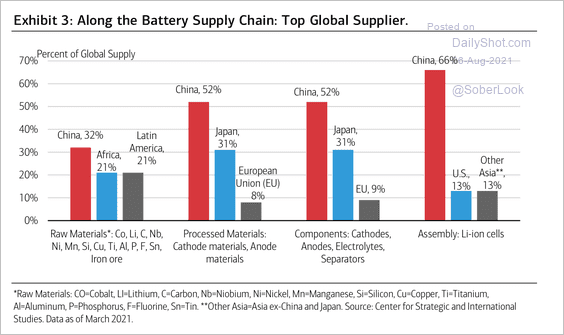1. China has Commanding Position Across the Global Battery Supply Chain
China: China has a commanding position across the global battery supply chain.
Source: BofA Global Research
2. The China Century?
Bloomberg–China Century Missing In World’s Most-Valued Equity-The dearth of Chinese enterprises at the top of the market capitalization rankings is a referendum on the world’s second-largest economy.
Matthew A. Winkler-The past two decades were widely assumed to usher in the transition from the “American Century” to the “Chinese Century,” as evidenced by the most populous nation’s burgeoning gross domestic product, dominance in manufacturing and global trade and, most recently, advancing technology poised to overtake just about everything in the West.
The world’s money says not so. China’s juggernaut is a shadow of its perceived self in the market capitalization of the world’s 10 largest companies, seven of which are American, accounting for more than 78% of the group’s shareholders equity, according to data compiled by Bloomberg. Aside from a brief ascendancy with four, or 42%, of the top 10 in 2008 during what was then the worst U.S. recession since the Great Depression, China remains an also-ran. Investors increasingly eschew fossil fuel — China is the No. 1 polluter with 30% of CO2 emissions, twice the amount produced by the U.S. — as climate change’s existential threat accelerates the preference for innovation, especially clean, or alternative, energy.
America DominatesU.S. companies make up the majority of the most valued in the world
https://www.bloomberg.com/opinion/articles/2021-08-04/china-century-missing-in-world-s-most-valued-companies?sref=GGda9y2L

3. Hong Kong ETF -16% from Highs.
Hong Kong ETF pulls back to pre-covid 2019 levels on China crackdowns
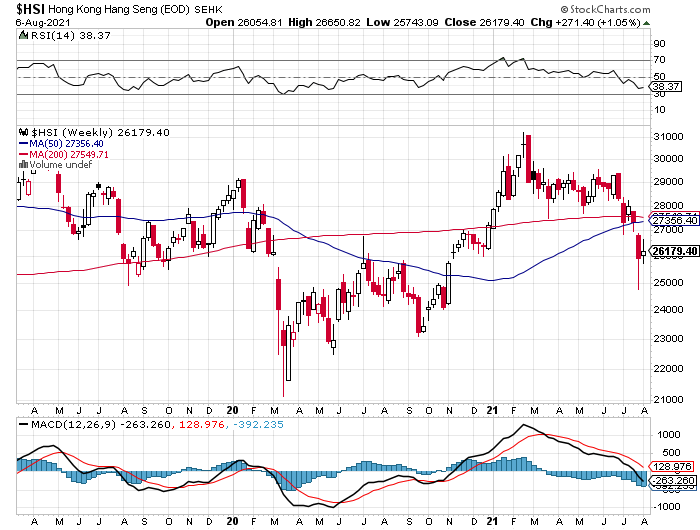
4. Tech Giant Softbank -38% from Highs
Softbank Hit a High of $50 in March
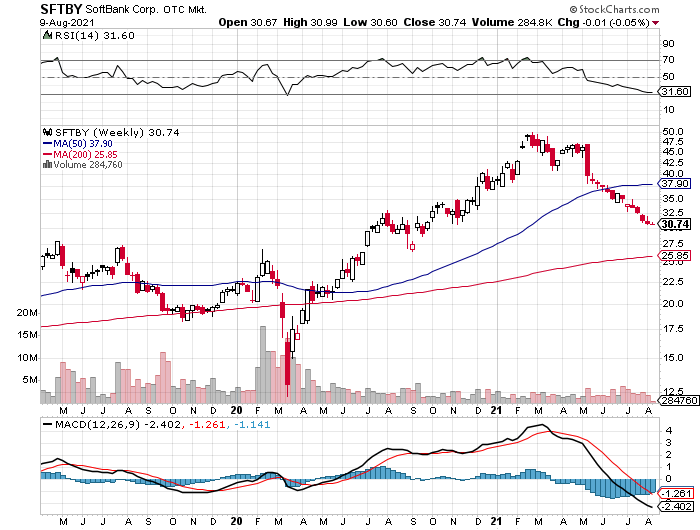
Marketwatch Phred Dvorak-The value of some of those investments sank during the April-June quarter, including Coupang Inc. CPNG, +1.78%, a Korean e-commerce company that listed in March, and Auto1 Group AG1, -4.29%, a German online used-car dealer that went public in February. In the latest quarter, the Vision Fund and its successor lost the equivalent of more than $6 billion collectively on the value of nine holdings, including Coupang, as the frenzy over some of tech’s hot listings cooled slightly. Those companies had helped generate tens of billions of dollars in largely paper gains for the two funds.
Even after accounting for those declines in value, the two funds still logged the equivalent of about $2.6 billion in investment gains in the latest quarter.
5. Companies Acquiring Amazon Businesses Growing Rapidly…$7B in Capital Raised Since April 2020
Firms acquiring successful brands on Amazon have attracted over $7 billion in capital raised since April 2020. They are known as Amazon seller aggregators. The market had a breakout year in 2020 because of three factors: the pandemic accelerating spending on Amazon, Thrasio raising hundreds of millions of dollars, and Anker, an Amazon-native brand, going public.
The capital pouring in is validating the Amazon marketplace as something serious. The businesses that sell on Amazon have grown mainly relying on measurable demand, controllable unit economics, and the predictability the data-rich marketplace provides through tools like Jungle Scout, Helium 10, and others. The firms rolling up those businesses use the same principles to evaluate and value them and grow them post-purchase. The types of companies those firms are looking to acquire are most often private-label sellers that use Amazon as one of their primary sources of distribution (some are also looking at brands using Shopify). There is no demand for resellers, nor do other marketplaces play a significant role.
Marketplace Pulse
https://www.marketplacepulse.com/acquirers
What is an FBA business?
For short, fulfillment by Amazon, or FBA, is an Amazon program that allows third-party sellers to offload most of their warehouse operations to Amazon for an extra fee. One estimate puts the number of third-party sellers on Amazon at around 5 million, with nearly all sellers using FBA (92%). This number appears to be growing exponentially at the moment, with more than 1 million sellers joining the platform the previous year. Achieving more than $200bn in sales last year, FBA businesses are now responsible for more than half of Amazon’s total sales – as shown below – and have drawn a lot of attention from investors known as FBA Acquirers.

Who are the FBA Acquirers?
FBA acquirers are digital consumer goods companies that acquire, develop and operate FBA businesses. With already 50 confirmed intuitional private equity acquirers, investors have poured almost $1 billion into buying up small merchants on Amazon last year. One of those institutions is Thrasio, founded in 2018 in Walpole, Massachusetts. Since then, Thrasio has been growing exponentially, becoming one of the largest FBA acquirers. In a matter of only two years, Thrasio has received a total of $1.6 billion in funding, hired 700 employees, and bought up to a hundred brands in its portfolio. The company is used to moving fast. On an average of 35 days, Thrasio can contact lucrative brands, exert a fair valuation based on value metrics, and offer between two to four times net profits plus salary (inventory to be determined) to purchase a brand.
M19 Blog
https://www.m19.com/blog/amazon-fbas-acquirers-the-state-of-the-art-in-consumer-goods
6. Bespoke-Pfizer (PFE) Partying Like It’s 1999
Last August 31st, well before the first studies on the effectiveness of COVID vaccines were published, Pfizer (PFE) was removed from the vaunted Dow Jones Industrial Average. Due to its low share price and the fact that the Dow is a price-weighted index, the Dow’s decision-makers decided to remove Pfizer (PFE) instead of competitor Merck (MRK) and replace it with much higher-priced Amgen (AMGN).
Coincidentally (or not), Pfizer (PFE) has easily outpaced Dow members Merck (MRK) and Amgen (AMGN) since the changes were made to the index last August. While Pfizer (PFE) is up 26% since it was removed from the Dow, both Amgen (AMGN) and Merck (MRK) have acted as drags on the index with declines of 10% and 7%, respectively. There is a stark difference in the chart patterns of the three shown below. (AMGN fell 6.5% today which is not yet included on the chart.)

Even after the big run it has had since the vaccine news came out late last year, Pfizer (PFE) is remarkably still trading below its all-time high made in April 1999. There aren’t a lot of blue-chip stocks left that are still below their highs from the 1990s, but PFE is one of them. After today’s move, PFE now needs to gain just 3.69% to break out to a new all-time high. You can bet that “breakout” watchers will be salivating at this one given the multi-decade resistance level that’s in place.
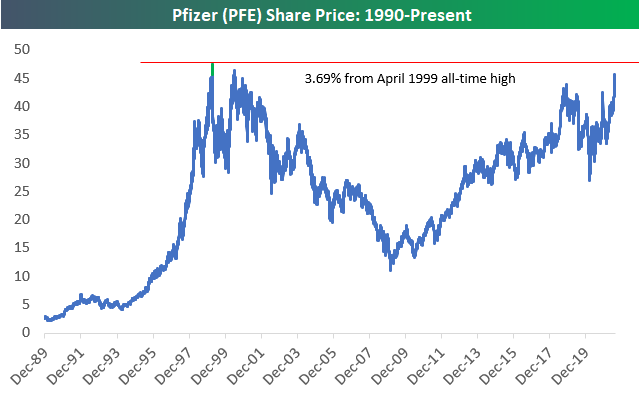
While PFE’s share price is still below its 1999 all-time high, long-term shareholders should at least be happy that the company pays a solid dividend. In fact, even though PFE’s share price is down since its all-time high made in April 1999, the stock’s total return (with dividends reinvested) over this time frame is +103%, which translates into an annualized return of ~3.2%. The impact that dividends have on total returns for investors cannot be overstated, and PFE is a perfect example.

The difference in share price change and total returns is even more dramatic the further back you go. Since 1990, Pfizer’s price change has been solid at 1,523%, but its total return is 2.7x that at +4,075%. On an annualized basis, dividends reinvested add more than three percentage points to PFE’s move since 1990 (total return=12.5% vs. price change=9.2%). Click here to view Bespoke’s premium membership options.
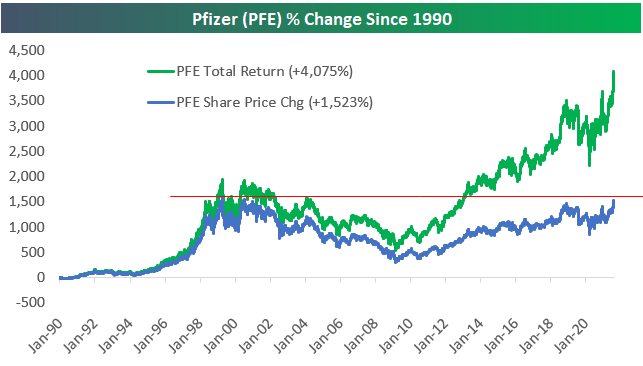
https://www.bespokepremium.com/interactive/posts/think-big-blog/pfizer-pfe-partying-like-its-1999
7. Service Workers See Gains Two Percentage Points Higher than Average for All Employees
MSN-But if policy makers can tamp down on the price increases, workers should do well. Data from the Labor Department show median wage growth was 4.8% in July on a 24-month annualized basis, up from a 3.3% pace in January 2020. Service workers saw gains almost two percentage points higher than the average for all employees last month.

© Bloomberg Sector Breakdown
That could help narrow income inequality, however slightly, after years of widening gaps amid fairly stagnant wages for the service industry accompanied by soaring salaries for white-collar workers. For the most part, corporate America expects wage increases to continue.
Corporate America Is Ponying Up for Workers Suddenly in Demand- Jordyn Holman, Leslie Patton and Peyton Forte
Jordyn Holman, Leslie Patton and Peyton Forte 20 hrs ago
8. European Airline Flights Improving
by Frank Holmes of U.S. Global Investors, 8/6/21
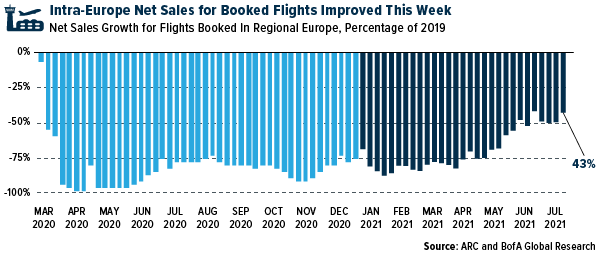
Advisor Perspectives https://www.advisorperspectives.com/commentaries/2021/08/06/how-to-participate-in-the-coming-electric-vehicle-ev-boom
9. Olympic Medals Per Million in Population
Food for Thought: 2021 Olympic medals per million population (for countries with over 1 million population):
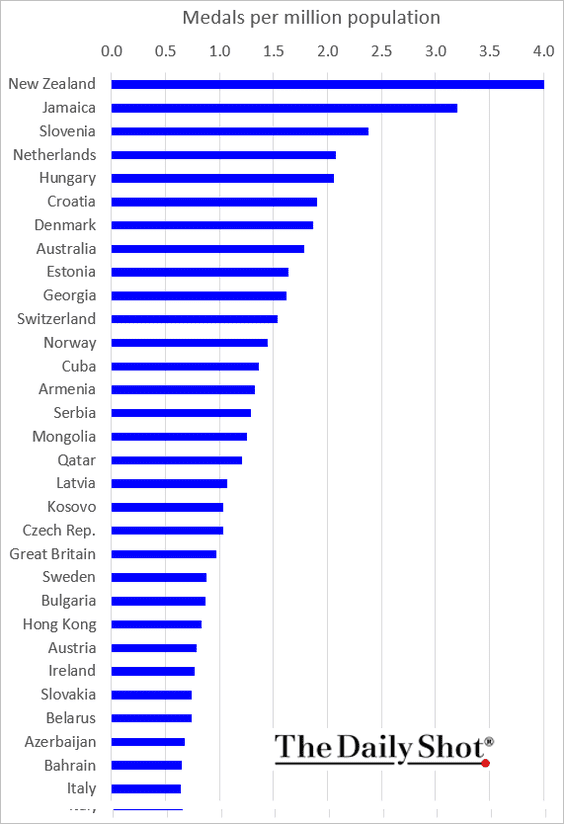
The Daily Shot Blog https://dailyshotbrief.com/the-daily-shot-brief-august-7th-2021/
10. 5 Ways To Hack Your Sleep Schedule
By Guest Contributor Last updated Jul 8, 2021
We all know that a good nights’ sleep is integral to just about everything we do. Yet it seems like many of us still do not get enough sleep. In fact, 35.2% of adults in the U.S. sleep less than 7 hours a night, which is the recommended amount. There are many reasons why we could have a hard time sleeping, maybe we had a coffee too late in the day or we took too long of a nap in the middle of the day. Whatever it may be, there are ways to optimize your sleep schedule so you can wake up feeling rested and refreshed.
Hack Your Sleep Schedule With These
Air Purifier
Investing in an air cleaning system could be the sleep remedy you’ve been looking for. When left to run free, pollutants and allergens like dust, bacteria, and fungi can trigger hay fever or allergy-like symptoms which disrupts sleep and results in restless nights. Many of us don’t even realize the amount of particles that irritate our sinuses, skin, and eyes that prohibit us from getting a good night’s rest. There are two options when it comes to ridding our air of these nuances, air purifiers and air filters. Air purifiers are machines that purify pollutants at the source, whereas air filters simply act as filtration systems that try to prevent the pollutants from coming in. Because air purifiers are more effective, they can be a more useful option.
Meditation
Practicing mindfulness is a remedy for a lot of health disturbances, one of them being lack of sleep. Mindfulness is the practice of actively and purposefully examining our experiences, actions, emotions, and thoughts. A study in JAMA Internal Medicine had two groups of adults look at two different methods of improving sleep. One group took sleep education classes, while the other group practiced mindfulness. After 6 weeks, the group that had been practicing mindfulness reported less depression, fatigue, and insomnia. Simply adding a short mindfulness exercise to your before-bed routine can help promote a more restful sleep.
Be Tired
This one may seem obvious, but many still don’t always follow it. When going to sleep, be tired. Many people know the feeling of tossing and turning in bed for hours before finally falling asleep. Experts say that if it takes more than 20 minutes to fall asleep, your body may not be ready to rest. They recommend getting up, going to a different room, and doing something relaxing like reading a book, listening to music or a podcast. By giving yourself the chance to actually feel tired, you will find that falling asleep won’t be as much of a problem as it was before.
Black Out
One of the biggest culprits in lack of sleep is light. Light is a key player in our body’s circadian rhythm. Our circadian rhythm is essentially our body’s internal clock that helps us feel tired at night and awake come morning time. The bright light of the day tells our brain that it is time for us to be awake, and the sun going down notifies us that it is time for bed. When light is present in times where we are supposed to be tired, it can mess with our circadian rhythm. While thin or light filtering curtains may be nice during the day, they could be disturbing our internal clock. Opting for black out curtains or a sleep mask can help omit any light from coming into your room.
Check The Temperature
Like light, temperature has more of an effect on our sleep than we think it does. When you sleep, your body enters an easily distrubed process called thermoregulation. If your room is too hot or too cold, it can prevent you from getting a good night’s sleep. According to experts, the ideal temperature for sleeping is around 65 degrees, give or take a couple of degrees depending on the person. When we sleep, our bodies lower in temperature by a couple of degrees meaning it is more comfortable in a lower room temperature than it would be during the day. Consider setting a night time schedule on your thermostat that puts your room at an optimal temperature for sleep.
Bottom Line
Sleeping is crucial for us to lead healthy and productive lives. Yet many of us still don’t clock in the amount of hours that we need to per night. These are just a few ways for us to optimize our sleeping environment and get the rest we all deserve.
About the Author
Chad Turner is a Certified Personal Trainer. He is a fitness enthusiast, personal trainer, health coach, and triathlete based out of Dallas, TX. His mission is to make the world of health and fitness more accessible to people from all walks of life
https://theselfimprovementblog.com/5-ways-to-hack-your-sleep-schedule/
